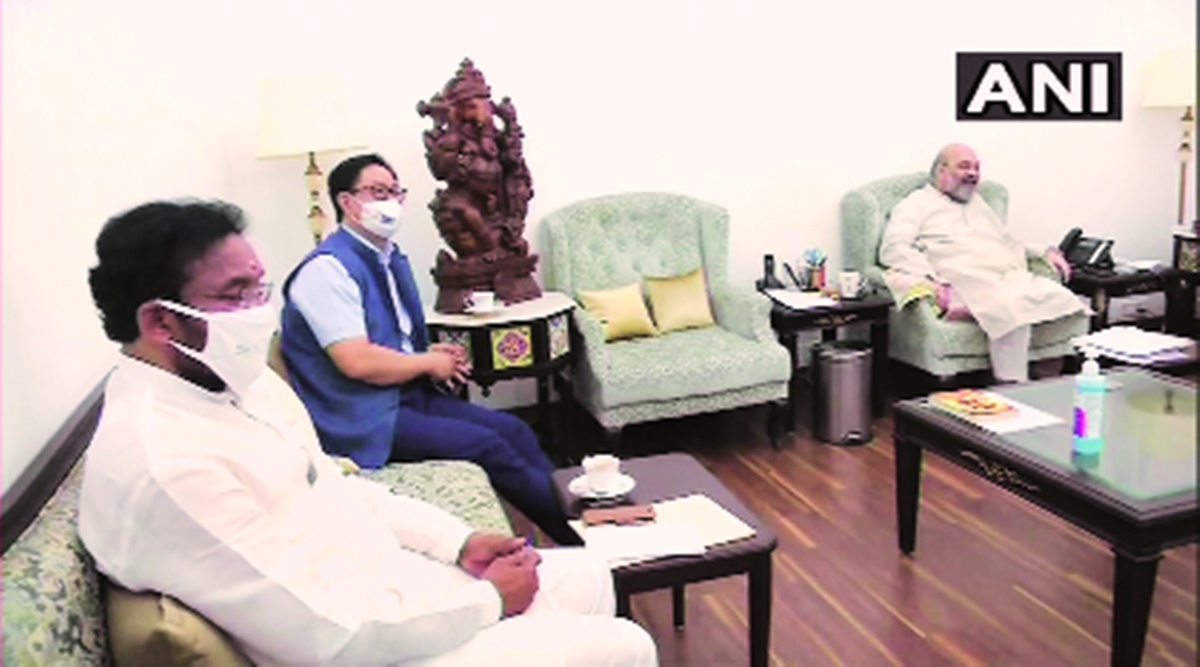 Union Ministers Amit Shah, Kiren Rijiju and Kishan Reddy at the meet with representatives from Leh on Saturday. Twitter
Union Ministers Amit Shah, Kiren Rijiju and Kishan Reddy at the meet with representatives from Leh on Saturday. TwitterThe Centre’s scramble to end an election boycott call by political parties in Ladakh culminated on Saturday with a delegation of political representatives flying to Delhi from Leh for a meeting with Union Home Minister Amit Shah to discuss their demand for a Bodoland Territorial Council-like arrangement in the Union Territory.
“We set out our demands and gave our version. We have been told that the Home Ministry will make a statement tomorrow,” Chering Dorjay Lakrook, former minister in the PDP-BJP government in the erstwhile state of J&K, said.
Dorjay said the decision to end the boycott of the October 16 Leh Ladakh Autonomous Hill Development Council (LAHDC) elections would depend on Sunday’s announcement. “We are hoping for a positive outcome,” he said.
The three-member delegation – comprising Dorjay, former MP Thupsten Chewang, and Thiksay monastery head Rinpoche Nawang Chmaba Stanzin – met with Shah, and Ministers of State for Home G Kishen Reddy and Kiren Rijiju.
While Dorjay quit BJP earlier this year, Chewang had left the party in 2018.
The simmering demand in Leh for a hill council with legislative powers since the time Ladakh and J&K were declared separate UTs boiled over earlier this month when all parties came together to declare a boycott of elections to Leh LAHDC. The last elections to the Council were held in 2015, and the five-year term of the present council expires on November 2.
The schedule for filing nominations began on September 2, and the last date is September 28. After scrutiny on September 29, the last date for withdrawal of nominations is October 1.
But after the September 19 notification of the election process, representatives of 12 political parties in the region, including the BJP and the Congress, and Buddhist and Muslim religious organisations jointly called for a boycott.
Not a single nomination has been filed yet.
“We had a very good meeting with the Home Minister. He gave us a lot of time, and reassured us that he will give us much more than Sixth Schedule,” Dorjay said.
With the Army and the Chinese People’s Liberation Army in a stand-off in eastern Ladakh, the boycott call created an unexpected political crisis in the UT, and the BJP has been scrambling to resolve it quickly.
BJP national general secretary Ram Madhav visited Leh on September 24. The following day, Leh shut down in protest against senior J&K BJP leader Ashok Koul’s purported remarks that the boycott call was “bakwas” (nonsense). Koul, who was accompanying Madhav, later said the media had twisted his words, and that his party supported the demand of Leh’s political class.
The boycott call was made by the apex group of People’s Movement for Sixth Schedule, an umbrella group of political parties and religious organisations, including the all-powerful Leh-based Ladakh Buddhist Association. They are demanding an autonomous hill council under the Sixth Schedule, modelled on the lines of the Bodoland Territorial Council in Assam.
The demand came up after last year’s constitutional changes in J&K, and was amplified by a student group called Students Organisation of Unified Ladakh.
Until August 5, 2019, Ladakh, which has two districts – the predominantly Buddhist Leh, and predominantly Muslim Kargil – sent four elected representatives to the erstwhile J&K state Assembly.
But over the years, Leh district felt marginalised by the J&K government, which was preoccupied with its own problems of autonomy, militancy, and separatism. In 1997, in order to deal with Leh’s demand to be freed of J&K – a demand not shared by Kargil district – and for Ladakh to be turned into a UT, the Centre set up LAHDC. Under an Act of Parliament that year, two LAHDCs were set up in Ladakh division of J&K, one for Leh and another for Kargil district.
LAHDC has a range of executive powers, and earlier functioned under the state government.
Since the changes of August 5, 2019, while Leh finally got its wish that Ladakh should become a UT, unlike the UT of J&K that had a Legislative Assembly, there was no Assembly for Ladakh. Except for the sole MP, Ladakh suddenly found itself disempowered.
With only executive powers under the LAHDC, and without the safeguards provided by Article 370 and 35 A, what Ladakhis now fear most is loss of land rights, and employment opportunities,and dangers to their identity, culture, language and heritage, especially if the domicile rules notified in J&K are extended to Ladakh.
“Earlier, we had the protection of 370 and 35 A. We want similar protection for Ladakh’s state land and private land, and for our identity and language, and jobs,” said Dorjay.
Ladakh’s population, under 2011 Census, is 1,34,000, the majority of them Buddhist.
The LAHDC has powers to decide use of state land, but Dorjay said while there was no intervention from the erstwhile state government in this regard, with the Council now directly under the Centre, concerns had increased this autonomy would be undermined
Unlike LAHDC, Bodoland Territorial Council, set up in 2003 after a peace agreement with Bodo Liberation Tigers, has legislative powers and jurisdiction over a notified area: Bodoland Territorial Region. It derives its powers through the Sixth Schedule, which was amended for the purpose.
The Sixth Schedule protects tribal populations in a non-tribal state, while Leh district of Ladakh is mostly tribal.
📣 The Indian Express is now on Telegram. Click here to join our channel (@indianexpress) and stay updated with the latest headlines
For all the latest India News, download Indian Express App.